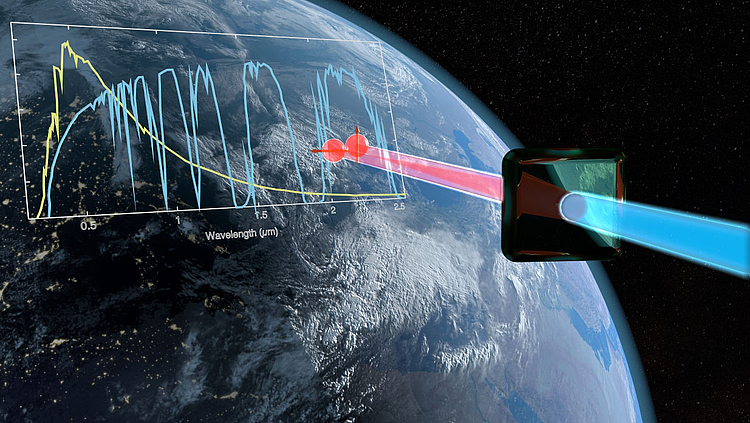Mar 30 2020
In association with Professor Dr Michael Kues from the Cluster of Excellence PhoenixD at Leibniz University Hannover, an international research team has devised a novel technique for producing quantum-entangled photons in a spectral range of light that was not accessible before.
 Generation of polarization-entangled photon pairs at a wavelength of 2.1 µm. Image Credit: Michael Kues/PQT.
Generation of polarization-entangled photon pairs at a wavelength of 2.1 µm. Image Credit: Michael Kues/PQT.
With this latest discovery, the encryption of satellite-based communications can be made relatively more secure in the days to come.
A team of researchers, comprising 15 members from Japan, Germany, and the United Kingdom, has created this innovative method for producing and identifying quantum-entangled photons at a wavelength of 2.1 µm.
In reality, encryption techniques, like quantum key distribution, use entangled photons to fully secure telecommunications that occur between two associates against eavesdropping attempts. For the first time, the study results have been presented to the public in the latest issue of Science Advances.
So far, the implementation of such encryption systems could technically be achieved only with entangled photons in the near-infrared range of 700 to 1550 nm.
But these shorter wavelengths have certain drawbacks, particularly in satellite-based communication: They are impeded by the Sun’s background radiation and also by light-absorbing gases present in the air. With present-day technology, end-to-end encryption of conveyed data can only be ensured at night and not on cloudy and sunny days.
The international research team, headed by Dr Matteo Clerici from the University of Glasgow, wished to overcome this issue with their latest discovery.
According to Professor Dr Michael Kues from the PhoenixD Cluster of Excellence at Leibniz University of Hannover, the photon pairs entwined at a wavelength of 2 µm would be considerably less affected by the Sun’s background radiation.
The so-called transmission windows are also present in the atmosphere of Earth, specifically for 2 µm wavelength. This thus leads to less absorption of photons by the atmospheric gases, which consequently enable more effective communication.
In their experiment, the scientists utilized a nonlinear lithium niobate crystal, and then using a laser, they delivered ultra-short pulses of light into the crystal. As a result, a nonlinear interaction resulted in the generation of the entangled photon pairs with a new wavelength of 2.1 µm.
The results of the study, published in the Science Advances journal, explain the details of the experimental system as well as the validation of the entangled photon pairs:
The next crucial step will be to miniaturize this system by converting it into photonic integrated devices, making it suitable for mass production and for the use in other application scenarios.
Dr Michael Kues, Professor, Cluster of Excellence PhoenixD, Leibniz University Hannover
Kues worked at the Institut National de la Recherche Scientifique - Centre Énergie Matériaux et Télécommunications (Canada), after completing his researches and doctorate in physics at the Westfälische Wilhelms University of Münster. At the Institute, Kues led the research team called “Nonlinear integrated quantum optics” for a period of four years.
He later shifted to the University of Glasgow and collaborated with the international group around Dr Matteo Clerici. From spring 2019, Kues has served as a professor at the Hannover Centre for Optical Technologies (HOT) at Leibniz Universität Hannover and, within the PhoenixD Cluster of Excellence, is now analyzing the development of innovative photonic quantum technologies, leveraging nanophotonics and microphotonics methods.
Kues is now planning to extend his research team comprising five members and has presently advertised two openings for research assistants (PhD positions).
The PhoenixD Cluster of Excellence
Between the years 2019 and 2025, the Cluster of Excellence PhoenixD, headed by Leibniz University Hannover, will receive about 52 million euros of funding from the State of Lower Saxony and the federal government through the German Research Foundation (DFG).
The cluster is an association of Laser Zentrum Hannover e.V., Physikalisch-Technische Bundesanstalt, TU Braunschweig, and Max Planck Institute for Gravitational Physics (Albert Einstein Institute).
Within the scope of the cluster, over 100 researchers from the fields of chemistry, physics, electrical engineering, mechanical engineering, mathematics, and computer science perform an interdisciplinary study.
The cluster examines the possibilities provided by digitization for innovative optical systems and also their production and use.
The cluster is organizing the PhoenixD Laser Day on October 20th, 2020 at Leibniz University Hannover. Researchers focused on the field of optics and photonics from Germany, the United States, Europe, and Australia will present their study results at the one-day conference.